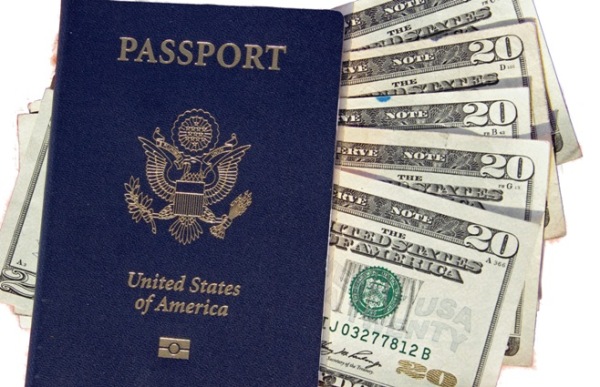
This may be the most important thing you read today. It’s certainly the most important thing we’ve written or expect to write.
We knew that our recently launched “How To” travel section needed to deal with money issues. After all, money is one of the primary reasons people do what they do and often the main justification for not doing what they want. We also knew that a site dedicated to perpetual travel like EverywhereOnce needed to think bigger on the topic. Simply offering money saving travel tips isn’t good enough. Instead, we wanted to frame money in a completely new way; one that gets our readers thinking more in terms of sustainability and freedom and less about the next vacation. We wanted to set the stage for the kind of large scale change that makes life on the road possible. In short, we want to completely alter the way you think about money.
Before we get to that, though, it’s worthwhile to reflect on the way people typically approach personal finance and why that approach so often leads to bad outcomes. Most of us think about our finances as a series of flows: income minus expenses. If income exceeds expenses we’re doing well, if they match we’re doing okay, if expenses are higher than income we’re in trouble, or soon will be. Intuitively this makes perfect sense and is true to an extent.
Monthly payments are an incomplete measure of cost
The problem with this approach is that it leads us toward a monthly payment mindset. We start believing we’re doing just fine as long as our monthly income is at least as large as our monthly expenses. If income rises, as it tends to over a working career, we tell ourselves that we can afford more and nicer things. We size large purchases, like houses and cars, so that our monthly payments roughly match our current cash flow.
What we rarely consider is that at some point income eventually stops. Expenses, meanwhile, continue until the day we die. If we’ve planned well, income stops because we’re able to retire voluntarily. If we’ve planned poorly, income stops because we become too old or sick to keep working. At that point the unaffordability of our “balanced” income minus expenses approach becomes painfully obvious.
Folks who thought they were doing well because they never spent beyond their means and because their checking account always balanced one day discover, often too late, that their lifestyle depended too heavily on a paycheck that was destined to end.
So what is the alternative?
If you were to consult a financial planner1 and ask “how much money do I need to retire?” they’d collect a ton of personal information, run a fancy Monte Carlo financial projection, print out pretty looking papers with lots of charts and numbers, charge you a generous fee, and then tell you something fairly similar to this: “You need to accumulate 25 times your uncovered annual expenses in savings.”2 By “uncovered expenses” they’d mean the amount by which your expenses exceed the income you expect to receive from pensions, social security and other continuing income streams.
25 times!
Let that sink in for a minute. For every dollar in spending we need to accumulate twenty five dollars in retirement savings.
 That is a basic rule-of-thumb. It comes with all kinds of conditions, caveats, and assumptions. Depending on circumstances, that number could be somewhat lower or it could be far higher. Knowing the rule of thumb does not replace the need for a detailed retirement plan and it won’t exactly fit every individual situation. What it will do though, if taken seriously, is change your relationship with money.
That is a basic rule-of-thumb. It comes with all kinds of conditions, caveats, and assumptions. Depending on circumstances, that number could be somewhat lower or it could be far higher. Knowing the rule of thumb does not replace the need for a detailed retirement plan and it won’t exactly fit every individual situation. What it will do though, if taken seriously, is change your relationship with money.
How? By altering the equation. No longer is a dollar of expenses equal to a dollar of income. Expenses carry far more weight; twenty-five times more to be exact. Instead of comparing monthly payments with monthly income, you start thinking about the giant lump sum of cash that is needed to sustain those payments in retirement. Everything looks more expensive, and less affordable, in this context.
At this point in the conversation, it is easy to despair. All of a sudden the financial situation for the average American, where savings is currently just 4.5% of income, looks mighty precarious. Accumulating a savings balance of 25 times annual expenses is a daunting task.
Expense control is an extremely powerful financial tool
The good news is that we each have tremendous control over our expenses. The better news is that our financial future is significantly leveraged to how much we spend.
If what we just said is true, that a dollar in annual spending requires $25 in retirement savings, it is equally true that our savings needs decline by $25 for every dollar in annual spending we eliminate. That relationship sets up powerful incentives to slash spending.
Cutting out the daily three dollar latte seems trivial from a monthly expense perspective. Why bother? Things look quite different once we realize that eliminating the latte reduces our savings requirement by $27,000. 3 That’s right, deep-sixing the daily latte reduces the amount we need to save for retirement by $27,000. How does Folgers taste now?
Be happy, save money
Thinking about money this way offers psychic rewards as well.
For most people, buying something activates pleasure centers in the brain. We like acquiring new things. It makes us happy, at least for a little while. Saving money, meanwhile, is painful. It requires sacrificing current pleasure for some murky future benefit. The “25 Times Principle” turns this whole relationship upside down by putting a very large price tag on current expenditures.
 Instead of feeling good about our shiny new bauble, we’re forced to consider the damage its purchase causes to our financial future. Not spending, meanwhile, moves us 25 times closer to our financial goals and, more importantly, to the life we want. Suddenly we realize tangible, quantifiable, and immediate benefits by foregoing spending where previously there was only pain. This psychic 180 has the potential to completely reprioritize our financial lives, making it easy and even enjoyable to stay on track.
Instead of feeling good about our shiny new bauble, we’re forced to consider the damage its purchase causes to our financial future. Not spending, meanwhile, moves us 25 times closer to our financial goals and, more importantly, to the life we want. Suddenly we realize tangible, quantifiable, and immediate benefits by foregoing spending where previously there was only pain. This psychic 180 has the potential to completely reprioritize our financial lives, making it easy and even enjoyable to stay on track.
It also has the potential to change the way we see the entire material world. I already suspect that many of us will never look at a three dollar latte the same way again. The same holds true for big houses, fancy cars, designer wardrobes and anything else we’re told we should want. Instead of viewing these things as objects of desire, it’s now possible to see them for what they really are: albatrosses that make it impossible for us to ever stop working.
At 25x, the stack of money needed to support the Jones’ lifestyle in retirement is simply too large for most of us to seriously consider. Once you see the world this way, it is hard not to feel a little bit of sympathy for the Jones family. The desire to keep up vanishes.
Realizing these benefits requires one simple change: we need to value financial independence. We need to value a future were we have a chance of saying goodbye to paid work. The good news is that even if we value that future 1/25th as much as we value today’s purchase, putting that item back on the shelf is still an even money trade. And that’s a trade we can feel good about all day long.
—————————–
Footnotes:
1 The information contained on this website and from any communication related to this website is for information purposes only. Neither Brian nor Shannon are registered financial advisors and do not hold themselves out as providing any legal, financial or other advice. We do not represent that any financial suggestion made here or elsewhere is suitable for you. Please consult your own financial advisor.
2 The “25 times” rule of thumb, alternatively known as the 4% safe withdrawal rate, was first quantified in research called the Trinity Study. The basic concept is that a portfolio of stocks and bonds has historically supported an inflation adjusted annual portfolio withdrawal of 4% for periods as long as 30 years with relatively high levels of success. Subsequent research has added to and refined this initial study. As always, past performance does not guarantee future results.
3 $3 * 365 * 25 = $27,375
4 Image of shopping girl courtesy of Photostock




















Very insightful post – I like that you attack the desire for instant gratification and status purchases, which is (for me, at least), one of the most difficult obstacles in sticking to a savings plan. Thanks!
LikeLike
I agree with your observation. Sticking with a savings plan is very difficult for many reasons. What’s so powerful about this idea is that by changing the way we think about money and how we measure affordability, saving becomes something we do simply because buying things becomes less attractive, less pleasurable, and more costly. Instead of something we have to work at, savings becomes a byproduct of the way we measure cost.
LikeLike
You are so right! I think I’ll mentally multiply by 25 the price tags of all non-essential items in the shops in future. Sometimes such a simple trick can be truly revolutionary. You put me in mind of my grandmother’s approach in the run-up to her retirement in the 1970s – for more details, please see http//:www.debbieyoung.info/2010/02/07/a-two-sheet-solution/
LikeLike
It’s a great trick that definitely changed the way we look at the world.
LikeLike
Loving the post – got me thinking about my financial life as well as the health of it! I tend to save money first for retirement and make sure to set a little bit aside after bills to save or maybe have a tiny bit of fun. I prefer to be independent versus relying on some type of system down the road. I have learned that YOU have to look out for YOU – career, finances, etc. Thanks for sharing!
LikeLike
A desire for independence is critical. What motivated me to save initially was my extreme distaste for being financially dependent on my employer. From the very first day I started working I realized that the power relationship between me and my boss was lopsided against me – I needed my job badly but he didn’t really need me much at all. The only way I could change that relationship is by setting aside enough money so I could afford to be out of work for 3 months, then six months, then . . . It’s wonderfully liberating to wake up in the morning knowing you can tell your boss to stick it if you absolutely need to.
LikeLike
I like this. The idea of financial independence is so different than dependence on material things for happiness.
LikeLike
One of my favorite movie quotes: “The things you own end up owning you.”
Bonus points for anyone (not named Grant) who identifies this quote (sorry Grant. This one is too easy for you).
LikeLike
The quote is from Fight Club! Great post! Being responsible financially is very difficult when we’re being sold things left and right and the pull of instant gratification is always in our face.
LikeLike
Thanks for your post. Saving is definitely a difficult thing to do, and you’re right on with the instant-gratification factor. So many of us are living with a day-to-day, or month-to-month, agenda that it’s difficult to clearly see the long-term damage we can do to our potential nest egg with such simple purchases. I think everyone would skip out on a daily latte (or other compulsory extras) if they knew it’d cost them $27K. Thanks for the perspective.
LikeLike
Thanks for your comments. The $27,000 figure is shocking, isn’t it?
LikeLike
I don’t know about a movie quote but there is something very similar in Toni Morrison’s novel “Song of Solomon.” Anyway, great advice. Thanks!
LikeLike
The gross over consumerism of our society has caused several problems.
It’s wonderful to find other people who think the same way. There is no need to work even harder for raises that most will eventually spend on a bigger house, car, etc. The key is to eliminate debt and to not be so dependent on money. Like most people, I am working a job that I do not enjoy but must keep in order to pay my monthly expenses. My boyfriend and I are currently working on our 3-4 year plan. Eliminate debt, save money and move out of the country to live a much simpler lifestyle.
Great post! Thanks for sharing.
LikeLike
Thanks – this is truly food for thought. Maybe not as yummy as my Thanksgiving turkey … but probably more useful.
LikeLike
Man can not live on savings alone . . . we need turkey too. Happy Thanksgiving!
LikeLike